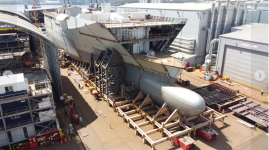- Reaction score
- 7,926
- Points
- 1,160
No probs. The engineering spaces are generally the entire width of the ship, so if you can get them in drydock it's just a matter of cutting off the hull plate and then replacing it when you are done. It's the same principle with putting up new drywall after tearing down the old stuff. Just do your weld inspections and good to go.
For some spaces on the frigate, there are removable panels in the deck/deckhead. This allows you to unbolt the panel, remove it, and then move equipment that is too large to fit through hatches. Something as mundane as a large office printer or pop machine can't fit down a hatch very well.
Repairing hull welds can be fun; there is always at least some x ray inspections on top of the normal non destructive testing.
Usually there are enough bits that need replaced that it's not necessary, but not uncommon for the shipyard to cut access holes in the hull to make the tank repainting faster. It can save them weeks, and as long as they are between ribs, it's relatively easy.
Believe there are still some equipment where it's less work to move things out of the way and cut a hole in the side while it's in the dock than break it down to go through the soft patch. DWPs are weird that way, but sometimes you are looking at a few hundred hours of welding vs thousands of hours of rigging and removals, so kind of a no brainer.








